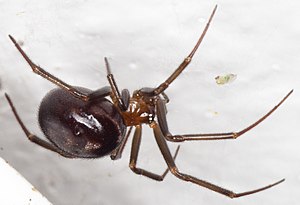Big fat spider
| Big fat spider | ||||||||||||
|---|---|---|---|---|---|---|---|---|---|---|---|---|

Large fat spider ( Steatoda grossa ), female |
||||||||||||
| Systematics | ||||||||||||
|
||||||||||||
| Scientific name | ||||||||||||
| Steatoda grossa | ||||||||||||
| ( CL Koch , 1838) |
The large fat spider ( Steatoda grossa ) is a species of spider from the family of the hood-web spiders (or ball spiders, Theridiidae ). She is one of the greatest representatives of the family in Central Europe . The species probably originally comes from the tropics and, like the greenhouse spider, has meanwhile established itself worldwide as a synanthropic species. The big fat spider is very rare in Central Europe and so far has only been detected in houses.
description
Males reach a body length of five to seven mm, females seven to ten millimeters. The coloring is very variable. The prosoma (front body) is usually light brown in color. The basic color of the opisthosoma (abdomen) is usually dark brown to black and shows white spots. This usually consists of an arched spot on the front edge of the opisthosoma and a subsequent row of four crescent-shaped spots that get smaller towards the back. The first two spots are supplemented by smaller spots on the right and left. Animals that are almost monochrome or very light-colored are less common. The legs are always monochrome without curling.
distribution and habitat
The original home of the species is unclear, it probably comes from the tropics. Today it is distributed worldwide as a synanthropic species. The big fat spider has so far only been found in house cellars in Central Europe, especially in large cities. Here too, however, it is only very rarely detected. The species is more common in southern Europe, where it can also be found outdoors and in caves.
Way of life
Like most members of the family, the great fat spider also builds a coarse-meshed network of more or less randomly arranged catch threads. In the US at least, the species is known to prey on spiders, including large ball spiders of the genus Latrodectus . Females produce three or more egg cocoons. Males can live up to 1.5 years; however, they usually die shortly after copulation. Females can live up to 6 years of age.
Danger
The species is widespread. In Germany it is classified as "safe" in the Red List .
gallery
Detail of the prosoma of a female
Female with a captured fly
Web links
- Steatoda grossa in the World Spider Catalog
- Brief description of Steatoda grossa on the Pennsylvania State University website, Dept. of Entomology
literature
- Heiko Bellmann: Cosmos Atlas Arachnids of Europe . 3rd edition, 2006. Kosmos, Stuttgart, ISBN 978-3-440-10746-1 .
- Ralph Platen, Bodo von Broen, Andreas Herrmann, Ulrich M. Ratschker, Peter Sacher: Total species list and red list of spiders, harvestmen and pseudoscorpions of the state of Brandenburg (Arachnida: Araneae, Opiliones, Pseudoscorpiones) with information on frequency and ecology. Nature conservation and landscape management in Brandenburg 8, booklet 2 (supplement); 1999.







